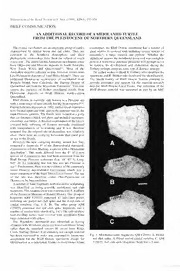
An additional record of a meiolaniid turtle from the pleistocene of northern Queensland PDF
Preview An additional record of a meiolaniid turtle from the pleistocene of northern Queensland
W Transactionsofthe RoyalSocietyofS.Ausl. (1 ), 123(4), 153-154. BRIEF COMMUNICATION AN ADDITIONAL RECORD OFA MEIOLANIID TURTLE FROM THE PLEISTOCENE OF NORTHERN QUEENSLAND The extinct mciofaniids are anenigmatic groupofturtles counterpart, the Bluff Downs meiolaniid had a numbero\' characterised by cranial horns and tail clubs. They are giant reptiles to contend with including several species of confined to the Southern Hemisphere and their crocodile13, a large varanid and python*. Whether the phylogenelic relationships have been the subject of much significantarmourthemeiolaniid possessed was enough to discussion1.Theoldest knownAustralian meiolaniidscome protect it from these potential predators will perhaps never from Oligocene and Miocene deposits in South Australia, be known. Its development and elaboration during the New South Wales and Queensland24. Most of the Tertiary perhaps suggests some sort ofdefence strategy. Australian material collected to date however, comes from TheauthorwishestothankE. Gaffneywhoidentifiedthe Late PleistocenedepositsofLordHowe Island5''.Thereare specimensand R. Molnarwhofacilitated the identification. additional Pleistocene occurrences of meiolaniid from The Smith Family of Bluff Downs Station continue to Walpole Island, New Caledonia, the Darling Downs of provide assistance and support for the ongoing research Queensland and from the Wyandotte Formation7 This note into the Bluff Downs Local Fauna. The collection of the . reports the presence of further meiolaniid fossils from Bluff Downs material was supported in part by an ARC Pleistocene deposits of Bluff Downs, north-eastern Queensland. Bluff Downs is currently only known as a Pliocene site with a wide range oftaxa alreadyhaving been reported8 u. During field investigationsfn 1992,furtherfossil exposures werelocatedupstream from,andon theoppositesideto,the main Pliocene quarries. The fossils were located in a gully that cut through a black soil plain and included mammals, crocodilesand turtles. Adetailed examination ofthe fossils revealed little softening of features normally associated with transportation or re-working and it was therefore assumed that the original site ofdeposition was relatively close. There were no overlying formations that could give an age to the fossils. However, the new collecting locality, named Jaw Site, contained a diagnostic P? of the diprotodontid marsupial, /,\gomatitrnstrilohusMacleay,aspecieswithaPleistocene distribution13 This tooth differed from the P' of a new . species ofZyi>omatarus that had been recovered from the Bluff Downs Pliocene sediments (Lat. 19° 43' S, Long. 143'' 36' L), indicating that Jaw Site was not Pliocene in age"'. Furthermore,therewasnoevidenceofthecommonly found Pliocene diprotodontid Euryzyxoma which was a mnjoi component ofthe BluffDown Local Fauna*.Theage of the site was therefore either Plio-Pleistocene or Pleistocene by biocorrelation. A numberofbonefragments with distinctive sculpturing was identified as being possible meiolaniid tail club fragments.This identification wasconfirmed by H.Gaflney oftheAmerican Museum ofNatural History. One groupof fragments (QM F25854) contained 12 individual pieces including one partial tail club spike and the distal ends of caudal vertebrae (Fig. I A. B). The other group (QM F25KXS) contained two tail club spike fragments and a numberofsmallerbone shards(Fig. I C>.Thetailsofthese land-dwelling turtles were covered with articulated bony rings armoured with spikes. The Wyandotte meiolaniid was identified as having affinities with Met'olamaplatycepsfromLord Howe Island rather than the mainland species M. oweni from Kings Greek, Darling Downs3 Unfortunately notenough material . QM has been recovered to make any constructive taxonomic Fig. 1. Meiolaniidturtle fragments. F25854.A. Partial QM assignment for the Bluff Downs specimens except for tail club spike. B. Distal end ofcaudal vertebra. C. identification asa meiolaniid. Unlike its Lord Howe Island F25855.Tail club spike fragment. Scalebar=5 mm. >| I Piugram Grunt to M. Archer. a grant from the Department A. Bartholomat, and grants in aid to the Riversleigh ofArts, Sport, the Environment Tourism andTerritories to Research Projectfrom the University ofNew South Wales, M. Archer, S. Hand and H. Godthelp, a grant from the Wang Australia Ply Ltd. ICT Australia and the Australian National Estate Program Grants Scheme to M. Archer and Geographic Society. 4XG0a.lTney,E.S.(I^83) Bull. Am.Mus. Nat. Hist. 175,361- 1"1TMhaocmksneosns,,S.B.A.S.&(1M0a0c5k)neMsesm,.BQ.i\S.M(u1s0.003)8,Tr6a0n3s-.6R0.0.Soe. Wooclburne. M. ()., Mad'adden, B. ,|„ Case, J. \„ S. A. 123, 101-105. SMp.ri&ngSeprr,iMng.erS.,,KF.leBd.ge(,10N0.3)S..J.PVoewrte.r,PaJl.eoDn.t,oWl.oo1c3l.b4u8r3n-e5,15J.. S11oWci.llNi.sS,.PW..M1.16.A.14&3-1M5a1c.kness, B. S. (1006) Proe. Linn, 1(Giaallif'nneeyy,,KE..S.S.(,IOAXrcIh)eArm,.MM.us.&NWovhiitl.e,272A0..(I103082.) The 6140W5r-6o1e2,.S. & Mackness, B. S. (I00X) Mem. Qd. Mus.42. Beagle. Ree. N. T. Mus. Arts Set. 9, 35-47. "Murray, F. F. (1002) The Beagle. Ree. N.T. Mus. Arts Gal'fney,E. S. (1985) Am. Mus. Novit. 2805. 1-20. Sci. 9. 80-110. ' Gaffney, F. S. (1006) Bull. Am. Mus. Nat. Hist. 229. I- '"Black, K. & Mackness, B. S. (1000) Diversity and 166. relationships of diprolodontoid marsupials //; Archer. M., Gafi'ney, E. S. & MeNamara, G. (1000) Mem. Qd Mus. Arena, R., Bassarova. M.. Black, K.. Bramtnall,J.. Cooke, 28. 107-113. B.. Greaser. P.. Crosby. K.. Gillespie. A.. Godthelp. H.. Archer. M. (1076) Ibid, 17, 370-307. Gr.ii. M„ Hand, S.J., Kear, B., Krikman,A.. Mackness, B.. Boles, W. E. & Mackness, B. S. (1004) Ree. S Aust Muirhead,.1,. Musser,A..Myers,T.. Pledge; N.,Wang, Y,& Mus. 27, 130-140. Wroe. S. (Eds) The cvolulionary history and diversity of "Mackness, B. S. (1005) Emu. 95. 265-271. Australian mammals. Aust. Mammal, (in press). BRIAN MACKNESS, School of Biological Sciences, University of New South Wales Kensington NSW 2052, Present address: PO Box 560 BeerwahQld4510. E-mail: [email protected]
